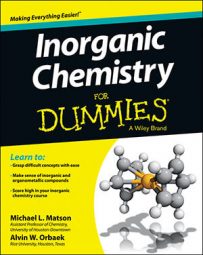All of this can be understood and explained using the concepts offered by the study of inorganic chemistry.
The periodic table
The periodic table is like a shelf that is used to organize all of the elements found in nature, and even some that are man-made.
It is useful because it arranges each element into a box, sort of like how you arrange your kitchen into hot spices, sweet spices, sugar, and flour, for example. So when you want to cook up a storm, you know where to get the ingredients necessary; you can think of the periodic table elements as nature’s list of ingredients.
Learning the properties of each ingredient and knowing what happens when they are mixed at certain concentrations at specific temperatures and pressure is what an inorganic chemist does.
The periodic table can be used to determine the following properties of materials:
-
Atomic number (Z): Elements are organized according to their atomic number and arranged in order from low atomic numbers to high atomic numbers. The atomic number itself can also tell you lots about the element; it can help you understand the valency, the coordination number, and the position you would expect to find it on the periodic table. Atomic numbers range from 1 to 118. The atomic number represents the number of protons that exist in the nucleus.
-
Number of protons: The proton makes up a part of the nucleus. It’s a positively charged particle that is counterbalanced by electrons, but the electrons orbit around the outside instead. The number of protons can determine how many electrons can orbit around the atom; this, in turn, affects the reactivity and chemistry of the atom.
-
Reactivity: The reactivity of the elements increases going from left to right on the periodic table. Each element going from left to right tends to be more reactive. But, at the far right are the noble gasses, and they are almost completely inert. The reactivity increases as you go down the periodic table; for example, rubidium is far more reactive than sodium.
-
Electronegativity: This property determines how much the element attracts electrons. This is also a good measure of reactivity, because the more that an element attracts electrons, the more reactive it is. The most electronegative element on the table is fluorine. The electronegativity increases going from left to right, and it decreases going down the table.
-
Mass: As you go from left to right and from top to bottom, you are always adding more protons in the atom. This has the general trend to make the later elements heavier than the earlier elements. But you should realize that this is only a general trend, and there are some exceptions to the rule.
-
Density: As you go down the table, the density of the atom increases; as you go from left to right the density also increases.
Moving left to right across the periodic table shown in the following figure, the atomic size decreases because of the additional nuclear charge due to addition of neutrons and protons in the nucleus. As a result of this, the orbital electrons are more tightly bound, and the ionization energy increases because of that.

Modern marvels due to inorganic chemistry
Since the dawn of humankind, materials have played a pivotal role to our existence. The ability to make housing to fend off bad weather and wet conditions, for example, certainly made living much easier. But today, these kinds of elementary supports are considered staples of our everyday lives.
The materials we use today are far different from what we used in the past. Three elements — carbon, aluminum, and silicon — have helped the modernization process. There are many more elements that have played their part, or course, but these three are indisputable.
Carbon is a versatile element and can be blended with many other materials to make composites and alloys. Carbon is one of the most prolific elements on the periodic table; it’s the stuff of life, the backbone of DNA, and a cornerstone of modern society.
All of the great big buildings that you see around you in modern-day cities are made possible due to carbon. Metal that’s reinforced and alloyed with carbon is often strong and light, making it easier to use and longer lasting. Graphene, fullerenes, and carbon nanotubes show great promise for future use as additives to reinforce materials, making them even more wear resistant and longer lasting, while also lowering the weight.
As you learn more about this element you can be sure to find it in more and more everyday appliances as we move forward in time.
Aluminum, on the other hand, is a rather new material. It was not until very recently that aluminum could even be isolated from its very stable and more common oxide form. But since then it has become the go-to material for a number of applications.
In terms of space flight, there is a saying: If you want to make a spaceship you can pick any material you want, as long as it is aluminum. It’s been tried and tested to such an extent that it’s hard to replace at this stage. But eventually, it will likely be replaced by composite materials that are made of carbon.
In the meantime, it would not take much time for you to find examples of aluminum in your everyday experience — it can be found in trains, planes, and automobiles, and in kitchens, lunchboxes, and all types of appliances because it’s a durable, strong, lightweight, and weatherproof material.
Silicon is the most studied element on the planet. There is a multi-billion dollar industry that’s borne out because of the properties of this element.
It’s a semiconductor that has the potential, when doped, to become more conducting, or less conducting. This property gives silicon the capability for use in electronic materials and devices to make 1s and 0s that translate computer code into electrical impulses.
Coupled with the fact that silicon is one of the more abundant elements on the planet, it is set to be in use for the foreseeable future, maybe it will never go out of fashion.
The age of information technology could have been made possible without silicon, but it may have taken a lot longer and not be as prominent today as it is.
The discovery of oxygen
Oxygen was discovered by Swedish chemist Carl Wilhelm Scheele in 1772. He discovered that by heating mercuric oxide, a gas (later identified as oxygen) formed. Scheele called the gas “fire air” because it produced sparks as it came in contact with hot charcoal dust.
This story starts with Plato and his ideas on the nature of matter. Plato was a Greek philosopher who suggested that all matter was made of four essential elements — fire, air, earth, and water. This crude idea lasted for several centuries, almost uncontested, and spawned the Phlogiston theory, which in ancient Greek meant “burning up.”
The main precept of Phlogiston theory was that fire was itself an element, so at the time when something burned, the flames were considered evidence that fire (as an element) was being separated from the material.
This was the popular belief until Scheele’s experiment led French chemist Antoine-Laurent Lavoisier to prove, in 1779, that when oxygen was isolated, fire could be seen as a consequence of a chemical reaction, instead of as an element in the reaction. It was Lavoisier who named the element, oxygen.
By throwing out the Phlogiston theory, Lavoisier paved the way for modern chemistry. That made for dramatic changes in the science thereafter, and it was due in large part to the discovery of oxygen.
The discovery of helium
Upon its discovery by French astronomer Pierre J. C. Janssen in 1868, helium was thought to exist on the sun, but not here on the earth. As he was observing a solar eclipse in India, Janssen noticed a bright yellow spectral line.
The sun shines every day. Regardless of how far north or south you live on this planet, the sun can still reach you. The sun is a great big ball of fire several million miles away. In fact, it’s a huge nuclear reactor, filled with explosions that cause energy to be blasted away and emitted in all directions.
The light that you see from the sun comes from all the photons being sent out into space from the sun, and the color of the light can be used to determine what elements are present thanks to our understanding of electron energy levels and atomic spectroscopy. In short, the theory goes like this: Electrons orbit around an atom that holds as many electrons as is allowed for that atom.
Each electron has a certain discreet energy level, and when the electron is excited you can see the energy levels using a prism, for example. A prism splits up white light; it slows it down due to diffraction, and you can get the full spectrum of the rainbow from white light.
But some sources of white light are missing some bands of the rainbow colors; this depends on the source of the light. The bands that are missing act like fingerprints for chemical elements, and these “fingerprints” are unique, so you can use them to identify elements, even if they are very far away like the stars and other planets. It was by looking at the sun with such a setup that helium was first discovered.
The light from the sun had bands in it that were composed of an unknown material, like nothing that had been analyzed on earth yet. It was named after the sun, Helios.
The discoverer Janssen had to travel to India to make his observation during a solar eclipse in 1868. But it was later discovered that helium is present on the Earth, and later yet, it was discovered among uranium minerals.
It just goes to show that you don’t have to go all the way to the sun to find your answer — it’s probably right here among us already. You just have to learn to look in the right way.

